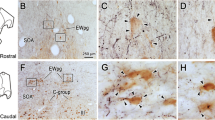Abstract
We have employed axonal transport and degeneration techniques to study the development of major rubral connections in the North American opossum. Opposums were chosen for study because they are born. 12 d after conception and have a protracted postnatal development. Our results suggest that: (1) The red nucleus innervates the spinal cord early in development, well before the somatic motor-sensory cortex (Cabana and Martin, 1984); (2) the red nucleus projects to the spinal cord before it receives substantial projections from the cerebellum or cerebral cortex; and (3) projections from the cerebellum reach the red nucleus significantly earlier than those from the cerebral cortex.
Similar content being viewed by others
References
Bangma G. C., ten Donkelaar H. J., Dederen P. J. W., and de Boer-van Huisen R. (1984) Cerebellar efferents in the lizardVaranus exanthematicus. II. Projections of the cerebellar nuclei.J. Comp. Neurol. 230, 218–230.
Bregman B. S. and Goldberger M. E. (1982) Anatomical plasticity and sparing of function after spinal cord damage in neonatal cats.Science 217, 553–555.
Bregman B. S. and Goldberger M. E. (1983). Infant lesion effect: III. Anatomical correlates of sparing and recovery of function after spinal cord damage in newborn and adult cats.Devel. Brain Res. 9, 137–154.
Cabana T. and Martin G. F. (1984) Developmental sequence in the origin of descending spinal pathways. Studies using retrograde transport techniques in the North American opossum (Didelphis virginiana).Devel. Brain. Res. 15, 247–263.
Cabana T. and Martin G. F. (1985) Corticospinal development in the North American opossum: Evidence for a sequence in the growth of cortical axons in the spinal cord and for transient projections.Devel. Brain Res. 23, 69–80.
Crutcher K. A., Humbertson A. O., and Martin G. F. (1978) The origin of brain-stem-spinal pathways in the North American opossum (Didelphis virginiana). Studies using the horseradish peroxidase method.J. Comp. Neurol. 179, 160–194.
Cutts J. H., Krause W. W., and Leeson C. R. (1978) General observations on the growth and development of the pouch young opossum,Didelphis virginiana.Biol. of the Neonate 33, 264–272.
DeOlmos J. S. (1977) An improved method for the study of the central nervous connections.Exp. Brain Res. 29, 541–551.
Hartman C. G. (1952)Possums. University of Texas, Austin.
King J. S., Martin G. F., and Conner J. B. (1972) A light and electron microscopic study of corticorubral projections in the opossum (Didelphis marsupialis virginiana).Brain Res. 38, 251–265.
King J. S., Dom R. M., Conner J. B., and Martin G. F. (1973) An experimental light and electron microscopic study of cerebellorubral projections in the opossum,Didelphis marsupialis virginiana.Brain Res. 52, 61–78.
Leonard C. M. (1973) A method for assessing stages of neuronal maturation.Brain Res. 53, 412–416.
Leonard C. M. (1974) Degeneration argyrophilia as an index of neuronal maturation: Studies on the optic tract of the golden hamster.J. Comp. Neurol. 156, 435–458.
Martin G. F. and Cabana T. (1985) Cortical projections to superficial laminae of the dorsal horn and to the ventral horn of the spinal cord in the North American opossum. Studies using the orthograde transport of WGA-HRP.Brain Res. 337, 188–192.
Martin G. F. and Dom R. (1970) The rubrospinal tract of the opossum,Didelphis virginiana.J. Comp. Neurol. 138, 19–30.
Martin G. F. and Fisher A. M. (1968) A further evaluation of the origin, the course and the termination of the opossum corticospinal tract.J. Neurol. Sci. 7, 177–187.
Martin G. F., Dom R., Katz S., and King J. S. (1974a) The organization of projection neurons in the opossum red nucleus.Brain Res. 78, 17–34.
Martin G. F., King J. S., and Dom R. (1974b) The projections of the deep cerebellar nuclei of the opossum,Didelphis virginiana.J. Hirnforsch. 15, 545–573.
Martin G. F., Beattie M. S., Bresnahan J. C., Henkel C. K., and Hughes H. C. (1975a) Cortical and brainstem projections to the spinal cord of the American opossum,Didelphis marsupialis virginiana.Brain, Beh. and Evol. 12, 270–310.
Martin G. F., Bresnahan, J. D., Henkel, C. K., and Megirian, D. (1975b) Corticobulbar fibers in the North American opossum (Didelphis marsupialis virginiana) with notes on the Tasmanian brush-tailed opossum (Trichosurus vulpecula) and other marsupials.J. Anat. (Lond.) 120, 433–438.
Martin G. F., Beals J. K., Culberson J. L., Dom R., Goode G., and Humbertson A. O. (1978) Observations on the development of brainstem-spinal systems in the North American opossum.J. Comp. Neurol. 181, 271–289.
Martin G. F., Cabana T., and Humbertson A. O. (1981) Evidence for lack of rubrospinal somatotopy in the North American opossum and for collateral innervation of the cervical and lumbar enlargements by single rubral neurons.J. Comp. Neurol. 201, 255–263.
Martin G. F., Cabana T., and Waltzer R. (1983) Anatomical demonstration of the location and collaterization of rubral neurons which project to the spinal cord, lateral brainstem and inferior olive of the North American opossum.Brain Beh. Evol. 23, 93–109.
McCrady E. (1938) The embryology of the opossum.Am. Anat. Memoirs, No. 16, The Wistar Institute of Anatomy and Biology, Philadelphia, Pennsylvania.
Mesulam M. M. (1978) Tetramethyl benzidine for horseradish peroxidase neurohistochemistry: A non-carcinogenic blue reaction product with superior sensitivity for visualizing afferents and efferents.J. Histochem. Cytochem. 26, 106–117.
Okado N. and Oppenheim R. W. (1985) The onset and development of descending pathways to the spinal cord in the chick embryo.J. Comp. Neurol. 232, 143–161.
ten Donkelaar H. J. and deBoer-van Huizen R. (1982) Observations on the development of descending pathways from the brainstem to the spinal cord in the clawed toadXenopus laevis.Anatomy Embrol. 163, 461–473.
Author information
Authors and Affiliations
Rights and permissions
About this article
Cite this article
Martin, G.F., Cabana, T. & Hazlet, J.C. The development of rubrospinal, cerebellorubral, and corticorubral connections in the North American opossum. Neurochemical Pathology 5, 221–236 (1986). https://doi.org/10.1007/BF02842937
Received:
Accepted:
Issue Date:
DOI: https://doi.org/10.1007/BF02842937




